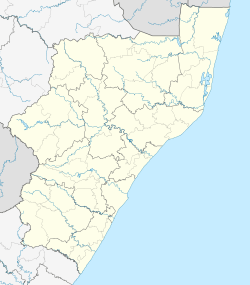Dingiswayo

| Dingiswayo | |
|---|---|
| Reign | 1806 – 1817 |
| Born |
1780 KwaZulu-Natal, near Melmoth |
| Died | 1817 (aged 36 or 37) |
| Issue | Somveli, Seyama, Mngoye, Sonkonde, Ngungumbana, Mthakathi, Mgcobo, Khuzwayo, Shuqu, Manqe |
| Father | Jobe kaKhayi |
| Mother | Mabamba kaDonda |
| Occupation | King of the Mthethwa Paramountcy |
Dingiswayo (Zulu pronunciation: [diŋɡisʷaːjo]) (c.1780 – 1817) (born Godongwana) was a Mthethwa chief, well known for his mentorship over a young Zulu general, Shaka Zulu, who rose to become the greatest of the Zulu kings. His father was the Mthethwa chief Jobe, and Jobe was the son of Kayi, who may be seen as the founder of the Mthethwa kingdom.[1] It was under Dingiswayo that the Mthethwa rose to prominence, mostly employing diplomacy and assimilation of nearby chiefdoms to strengthen his power base.
Early life
We first hear of Godongwana during the wanderings of Nandi and her illegitimate son Shaka, who settled with the Mthethwa under chief Jobe. Godongwana and his brother, Tana, plotted against their father Jobe, but their plot was discovered. Tana was killed and Godongwana made his escape. Nursed back to health by a sister, the young man found refuge in the foothills of the Drakensberg among the Qwabe and Langeni people. He changed his name to Dingiswayo, which means "he who is troubled", or "The Wanderer". Upon the death of his father, he returned to claim the chieftainship.
Chief of the Mthethwas
He found his brother Mawewe in power. He displaced him without resistance. Mawewe fled, but was lured back and killed.
He observed a troop of Khoikhoi under Lieutenant Donovan which had accompanied Doctor Cowan. Cowan was murdered by chief Phakathwayo, while their expedition attempted to reach Portuguese territory via Natal, and Dingiswayo subsequently acquired Cowan's horse and gun.[2] Dingiswayo's new military tactics were an adoption of western techniques of drills and formation movements under a chain of command.[2]
With Shaka as his general, he attacked the Amangwane under Matiwane about 1812 and drove them across the Buffalo river. It was the first of the Mfecane migrations - tribes displaced, latterly by the Zulus, and who in turn displaced others in a series of internecine wars.
Dingiswayo combined a number of smaller tribes to oppose his chief rival to the north, Chief Zwide of the Ndwandwe.
Death and legacy
In 1816 Shaka returned to the Zulu to claim chieftainship, while still recognising the larger Mthethwa and Dingiswayo as overlord. However, in the course of an attempted invasion of Zwide's territory, Dingiswayo was captured and beheaded by Zwide at Ngome, near Nongoma. His personal possessions were buried in his kraal. Dingiswayo's grave is on the north bank of the Tugela River, in KheKheKhe's kraal. The Mthethwa forces were defeated and scattered temporarily, with the remnants reforming under Shaka. Zwide was later defeated by Shaka in the Zulu Civil War.
Dingiswayo's career marked a watershed in the history of south-east Africa. During his exile he was exposed to European ideas and he put these into practice to produce a disciplined and highly organised army for the first time in the region. After his death, Shaka extended these ideas to create a rigidly disciplined society to complement Dingiswayo's military reforms.[3]
References
- ↑ Ade Ajayi, J. F. (1998). Africa in the Nineteenth Century Until the 1880s: Volume 6 of General history of Africa. University of California Press. pp. 102–104. ISBN 0520067010.
- 1 2 MacKeurtan, G. The Cradle Days of Natal (1497-1845). Pietermaritzburg. 1948
- ↑ Longman History of Southern Africa, Longman Publishing, 1978